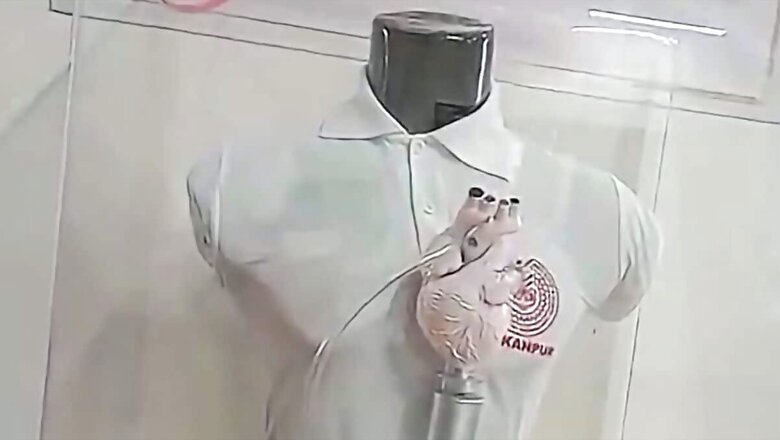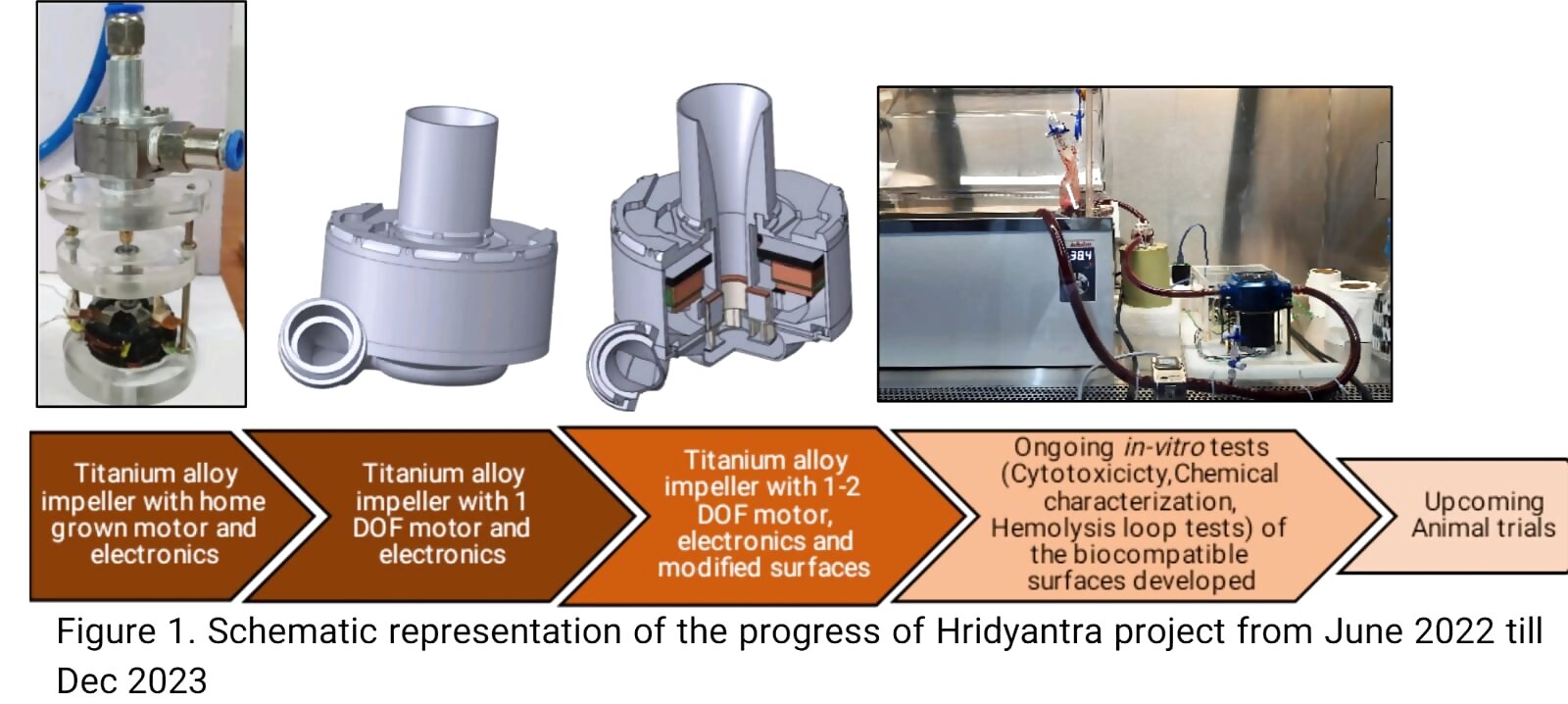
views
The country’s first ‘artificial heart’ or left ventricular assist device (LVAD), developed by the Indian Institute of Technology Kanpur (IIT-K), is all set to undergo animal trials in March 2025.
Dr Amitabha Bandyopadhyay, head, Department of Biological Sciences and Bioengineering, IIT-K, who played a crucial role in development of LVAD, called these trials a significant move towards creating an affordable, homegrown solution for end-stage heart failure, which would pave the way for human trials.
In an interview with News18, Dr. Bandyopadhyay shared insights into the journey of building an Indian version of LVAD, which is affordable than the ones available for around Rs 1 crore in the global market.
“After successfully completing a series of lab tests, India’s indigenously developed LVAD, labelled as ‘Hridaya Yantra’ is now all set for animal trials, scheduled to begin in March 2025. The trials will first be conducted on sheep, marking a crucial step toward validating the device’s efficacy before moving on to human applications,” said Dr Bandyopadhyay, chairman of R&D task force of School of Medical Research and Technology (SMRT).
WHAT IS LVAD?
An LVAD is a mechanical pump that helps maintain the heart’s ability to pump blood in individuals with severe heart failure. It specifically supports the left ventricle, the heart’s main pumping chamber, by taking over its function when it is too weak to pump blood effectively.
LVADs are often used in patients with end-stage heart failure as a bridge to heart transplantation or as a long-term solution for those ineligible for a transplant. The device is surgically implanted and works by drawing blood from the left ventricle and sending it to the aorta, which supplies oxygen-rich blood to the body.
LVADs do not replace the heart, but assist its function, offering a life-saving option when medication is insufficient. LVADs are currently expensive and usually imported, making them out of reach for many patients in India, Dr Bandyopadhyay explained.

THE BEGINNING
It all began in March 2022 when Dr Bandyopadhyay was presenting the institute’s research and development objectives to the advisory board.
During this meeting, renowned cardiac surgeon Dr Devi Shetty, chairman and founder of Narayana Health, raised a challenge. He suggested that if IIT-Kanpur could achieve such rapid, high-quality product development, why not develop an LVAD – a device currently out of reach for many Indians due to its exorbitant cost. “At present, LVADs are imported from the USA, costing around Rs 1 crore, making them inaccessible for many Indian patients. On an average around 5000 patients with end-stage heart failure require LVAD each year,” recollected Dr Bandyopadhyay.
The idea quickly gained momentum. Soon after the suggestion by Dr Shetty, IIT Kanpur launched ‘Hridya Yantra’, a challenge-based program aimed at developing an advanced artificial heart.
MAKING A DEVICE MIMIC HEART’S FUNCTION
The challenge, though accepted, was daunting as developing an LVAD — an advanced mechanical pump designed to function inside the human body — requires precision engineering of the highest order. The device not only has to mimic the heart’s natural function, but must also operate flawlessly within the complex environment of the human body. Mechanical engineering had to be of ultimate quality for this project.
“Recognizing the complexity of the task, IIT Kanpur launched a nationwide advertisement to recruit top experts in fields such as medical research, engineering, and product development. This initiative attracted a diverse pool of specialists from various disciplines, all working together toward a common goal: creating an affordable, indigenous LVAD,” said Dr Bandyopadhyay.
INSPIRED BY JAPAN’S MAGLEV TRAIN
“Usually, pumps make noise, generate heat, and are prone to malfunctions. However, the pump which has to function inside the human body must be silent to avoid disturbance to the patient, produce no heat to prevent tissue damage, and be incredibly reliable, functioning without failure for 10-15 years. This was the first challenge,” he said.
However, he said the team took inspiration from a Maglev train, or magnetic levitation train in Japan, where electromagnets are used to levitate the train above the track instead of wheels, which eliminates friction, allowing the trains to travel at higher speeds and makes it quieter and smoother.
PREVENTING BLOOD CLOTTING
The second challenge was ensuring that the pump could function effectively inside the human body. “Unlike regular pumps, this one has to pump human blood, which means preventing blood cell damage during mechanical action and avoiding blood clot formation,” said Dr Bandyopadhyay.
This required a high-quality design with precise engineering. Initially, the process relied on computer models, but after countless hours, days, weeks, and months of extensive research and development, the team managed to create an ideal pump, which is said to be the country’s first Maglev pump and also the country’s first LVAD, which is now ready for animal trials.
POWERING LVAD
Powering the LVAD pump inside the human body was another critical challenge. He said that the pump would be battery-operated and connected to an external battery pouch via a wire.
“Ideally, the battery should be inbuilt within the device, but the issue arises if the battery runs out of power or needs replacement,” he said.
This makes the external battery pouch the most reliable solution at present. Although less convenient, this method ensures the pump can be powered consistently without the risk of internal battery failure or disconnection of wire which dangles out the human body. Imported LVADs are similarly powered, requiring the patient to carry the pouch at all times.
INDIAN LVAD TO BE FOUR TO FIVE TIMES CHEAPER
The Indian version of the LVAD, which Dr Bandyopadhyay proudly described as a true ‘Make in India’ innovation, is not only highly efficient but also cost-effective. While the professor refrained from quoting the exact price, he assured that if the device successfully passes all tests and reaches the market, it will be affordable for common man.
“Currently, the LVAD in the global market costs around Rs 1 crore. However, the Indian version, he said, is expected to be almost four to five times cheaper.
HOPE FOR PATIENTS
On an average, congestive heart failure affects over 26 million people worldwide, with more than 50,000 lives lost annually in India alone, against which only 10-15 heart transplants are performed in India each year.
After the initial animal trials, the LVAD will undergo a series of regulatory animal trials and various other tests before it can be implanted in a human body. Despite the lengthy process ahead, the discovery of this indigenous LVAD has already sparked hope among thousands of patients suffering from end-stage heart disease, who currently cannot afford the costly imported devices.
MAGNIFICENT SEVEN
Other than Dr Bandyopadhyay, the team that contributed to the development of LVAD includes Professor K Muralidhar (mechanical engineering), Professor Niraj Sinha (mechanical engineering), Professor Pranav Joshi (mechanical engineering), Professor Kantest Balani (material science and engineering), Prof. Nikunj Bhagat (electrical engineering and biological sciences & bioengineering, joint appointee) and Prof. Jayandharan Rao (biological sciences & bioengineering).

















Comments
0 comment